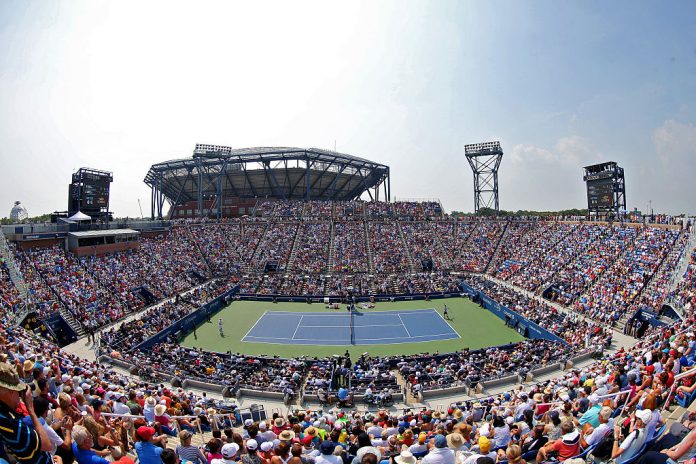What do Moses and the rock anthem “Stairway to Heaven” have in common with Satchmo and Jimbo and Jenny (Capriati) and Janis (Joplin)?
All have links with “The Lou” – that would be the US Open’s beloved Louis Armstrong Stadium, the American sports venue which has the most tumultuous history in recent memory. After 43 loud, bombastic seasons as a glorious tennis venue, the stadium will at last be demolished after the Open to make way for a newer, 15,000-seat model with a roof in 2018.
First called the Singer Bowl, it was conceived by New York City construction czar Robert Moses as a centerpiece stadium for the 1964 World’s Fair and went on to host rockers such as Led Zeppelin, Jimi Hendrix, Janis Joplin and the Doors. But for years the doors were essentially shut at the stadium, until USTA boss Slew Hester noticed the snow-covered relic as he flew over LaGuardia airport. Looking for a new venue to replace its outmoded Forest Hills setting, the entrepreneurial Hester played his trump card before there was Trump. Translation: In just a year, he managed to twist arms and pay the right folks to get the place built in a New York flash. With its 18,000 seats and fine sight lines, it quickly became the celebrated focal point of American tennis, where royals like Fergie and Hollywood’s finest viewed rogues and rebels playing the game at a whole new level.
“The Lou” was a mix of drama, athletic genius, taunts and tantrums which quickly became the compelling petri dish for the modern game. Here raucous, well-lubricated fans cheered vain, over-the-top and inspired characters with prime time egos and world-class athleticism. Armstrong was the site of arguably the best day in tennis – Super Saturday in 1984 – and an apocalyptic night in 1979 which was said to be the night modern tennis was born, the curious evening when an Ilie Nastase-John McEnroe match disintegrated and almost exploded into a full out riot.
At “The Lou” we saw Jimmy Connors 1978 run far off the court to rip one of the greatest shots in tennis history – a jaw-dropping one-handed backhand from around-the-post against the stunned Italian Adriano Panatta. Then there was Jimbo’s singular run to the 1991 semis. And there was another run. Bjorn Borg, the godlike European, ran out of “The Lou” to avoid the press after John McEnroe humiliated him in the 1981 final.
The Monica Seles-Capriati 1991 semifinal was one of the great matches in women’s history. Here Chris Evert said goodbye in 1989 after losing to Zina Garrison, while many a future star used Armstrong as a launching pad.
Barbra Streisand told us here that Agassi was a Zen Master. And in 1988, Andre’s future wife Stephanie Graf completed the most masterly of runs when she won the Open to secure the Golden Slam, having won all four majors and Olympic Gold.
It always seemed that “The Lou” was encountering upsets. No we are not talking about Pete Sampras’ upset stomach when he upchucked while playing Alex Corretja in the 1996 quarters. There were historic near-upsets, like when Pat McEnroe almost toppled Jimmy Connors at 1:25 a.m. in the first round in 1991, and when the low-ranked Lori McNeil almost shocked Steffi Graf in 1987. When the match went long, CBS chose to show it rather than the CBS Evening News. Irate, broadcaster Dan Rather famously stomped off the set. Yannick Noah was equally upset when, in the 1986 doubles final, Ken Flach wouldn’t admit that the ball had struck his hair. Another collision, the 1997 one between Irina Spirlea and Venus Williams, led to Richard Williams claiming the Romanian was “a big, ugly white turkey.”
Sadly in officials’ eyes, “The Lou” became a bit of a turkey, too. In 1997 it was knocked off its pedestal by the 23,500-seat, $262 million Arthur Ashe Stadium. Now “the Lou” was just a second thought, and to make matters worse, in 1998, it lost 8,000 of its seats, a move which actually had a savvy “less-is-more” logic to it.
But as other tennis venues, from Indian Wells to Wimbledon, became more lavishly glorious and spacious, the good old Lou – no matter how quaint and no matter how much tennis history it hosted – suffered from the test of time. Now, as part of a vast US Open expansion program, the stadium will be taking its own stairway to tennis heaven when it is demolished after this year’s Open. With its intimate feel, its raucous fans and fabulous memories, “The Lou” will be missed.



















